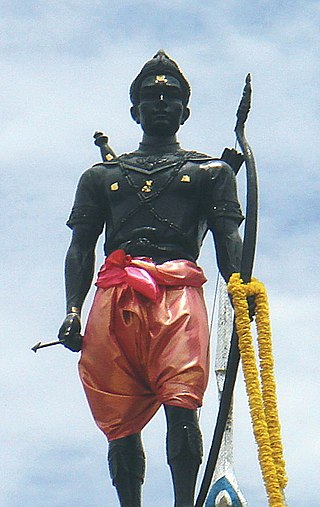
The Ayutthaya Kingdom or the Empire of Ayutthaya was a Mon and later Siamese kingdom that existed in Southeast Asia from 1351 to 1767, centered around the city of Ayutthaya, in Siam, or present-day Thailand. European travellers in the early 16th century called Ayutthaya one of the three great powers of Asia. The Ayutthaya Kingdom is considered to be the precursor of modern Thailand, and its developments are an important part of the history of Thailand.

Sukhothai Historical Park covers the ruins of Sukhothai, literally 'dawn of happiness', capital of the Sukhothai Kingdom in the 13th and 14th centuries, in north central Thailand. It is near the city of Sukhothai, capital of Sukhothai Province.

Ramkhamhaeng or Pho Khun Ramkhamhaeng Maharat was the third king of the Phra Ruang Dynasty, ruling the Sukhothai Kingdom from 1279 to 1298, during its most prosperous era.
The Nakhon Si Thammarat Kingdom, Nagara Sri Dharmarashtra or the Kingdom of Ligor, was one of the major constituent city states (mueang) of the Siamese kingdoms of Sukhothai and later Ayutthaya and controlled a sizeable part of the Malay Peninsula. Its capital was the eponymous city of Nakhon Si Thammarat in what is now Southern Thailand.

Borommatrailokkanat or Trailok (1431–1488) was the king of the Ayutthaya Kingdom from 1448 to 1488. He was one of many monarchs who gained the epithet King of White Elephants. He was the first Thai king to possess a "noble" or white elephant, which, according to Buddhist belief, was a "glorious and happy sign". His reign was also known for massive reforms of Thai bureaucracy and a successful campaign against the Lan Na Kingdom to the north. He was revered as one of the greatest monarchs of Thailand.

Maha Thammaracha I, born as Li Thai, was a king of the Sukhothai Kingdom, and the first Buddhist philosopher to write in the Thai language. He reigned from roughly 1347 until his death in 1368. Li Thai was the son of Loe Thai and the grandson of Ram Khamhaeng the Great.

The architecture of Thailand is a major part of the country's cultural legacy and reflects both the challenges of living in Thailand's sometimes extreme climate as well as, historically, the importance of architecture to the Thai people's sense of community and religious beliefs. Influenced by the architectural traditions of many of Thailand's cultures, it has also developed significant regional variation within its vernacular and religious buildings. Although Siam urged to identify themselves as a modernized state, Western culture and influence was undesirable and inevitable. In an attempt to become distinguished, Thailand's ruling elite gravitated toward selective Modernization to avoid the undesired Western influence.

The Ram Khamhaeng Inscription, formally known as Sukhothai Inscription No. 1, is a stone stele bearing inscriptions which have traditionally been regarded as the earliest example of the Thai script. Discovered in 1833 by King Mongkut, it was eventually deciphered and dated to 1292. The text gives, among other things, a description of the Sukhothai Kingdom during the time of King Ram Khamhaeng, to whom it is usually attributed. The inscription had immense influence over the development of Thai historiography from the early 20th century, which came to regard Sukhothai as the first Thai kingdom.

The lands situated in the present-day Phitsanulok Province of Thailand have been inhabited since the Stone Age, although the neolithic inhabitants of the region are not likely to have been the ancestors of the modern Thai people who reside there today. The earliest historical records relating to what is now Phitsanulok Province indicates that at a time prior to or during the 11th century, the present-day city of Phitsanulok was but a small strategic Khmer outpost known as Song Khwae. During the next century, in 1188, Nakhon Thai, located near the center of the present Phitsanulok Province, was established as the capital city of the Singhanavati Kingdom, an early city-state of Thailand. Later, during Thailand's Sukhothai Period, the city of Phitsanulok emerged as a major city in the east of the Sukhothai Kingdom, and the great temples of Wat Chula Manee, Wat Aranyik and Wat Chedi Yod Thong were constructed. In 1357, the renowned Wat Phra Sri Rattana Mahathat was erected, and the Ayutthaya Period witnessed the construction of several of the province's other chief temples. Phitsanulok served for 25 years as the capital city of the Ayutthaya Kingdom. In 1555, King Naresuan the Great was born in the city of Phitsanulok. Naresuan played a significant role in the history of Thailand, as he expanded the kingdom to its greatest territorial extent, by conquering sizable portions of modern-day Burma and Cambodia. In recent times, Phitsanulok Province has become an important agricultural center, part of the Bread Basket of Thailand, providing rice and other crops to consumers in Thailand and throughout the world. Extensive agricultural development over the last hundred years or so has spawned a modern infrastructure in the urban areas of the province, bringing with it an array of modern roads, universities, hospitals and other conveniences. Over the years, the Nan River and its tributaries have played a substantial role in the history and development of the region by providing a route for transportation, fertile soil for agriculture, and water for irrigation. The river waters have also served as a route for enemy invaders, and have been the source of periodic widespread flooding throughout the province.

Maha Thammaracha, Maha Thammarachathirat, or Sanphet I, formerly known as Khun Phirenthorathep, was a king of Ayutthaya Kingdom from the Sukhothai dynasty, ruling from 1569 to 1590. As a powerful Sukhothai noble, Phirenthorathep gradually rose to power. After playing many political turns, he was eventually crowned as the King of Siam.

The Si Satchanalai Historical Park is a historical park in Si Satchanalai district, Sukhothai Province, northern Thailand. The park covers the ruins of Si Satchanalai and Chaliang. Si Satchanalai, which literally means "City of good people", was founded in 1250 as the second center of the Sukhothai Kingdom and as a residence of the crown prince in the 13th and 14th centuries.
Ngua Nam Thum was a king of Sukhothai, an ancient kingdom in Thailand. He was from the House of Phra Ruang.

Si Inthrathit was the first king of the Sukhothai Kingdom, a historical kingdom of Thailand, and ruled from 1238 until around 1270. He is credited as the founder of the Phra Ruang (พระร่วง) Dynasty, itself credited as the first historical Siamese dynasty, having a double claim to this title: for being cradled precisely in the region designated by foreigners as "Siam", and for being the dynasty which freed the Thai principalities from the Khmer Empire
Chueang is the legendary hero of the Dai people who ruled as first king of the Lü Kingdom establishing a capital at Jinghong.
Maha Thammaracha III, born as Sai Luthai, was a king of the Sukhothai Kingdom. He was the son of Maha Thammaracha II and great-great grandson of King Ram Khamhaeng the Great.
Maha Thammaracha IV, born as Borommapan, was the last king of the Sukhothai Kingdom.

Pha Mueang was a Thai nobleman and general who was the Lord of Rad and played a significant role in the founding of the Sukhothai Kingdom.

Phitsanulok is a city in Northern Thailand, the capital of Phitsanulok province and the tenth-largest city in Thailand. It is 360 km north of Bangkok and has a population of 281,929 people as of 2021. The city was founded in the 13th century under the name Song Khwae and represents one of the oldest cities in Thailand.
Suphannabhum or Suvarnbhumi; later known as Suphan Buri was a city-state, that emerged in the early "Siam proper" which stretched from present-day west central Thailand to the north of the Kra Isthmus, with key historical sites at Uthong, Nakhon Pathom, Suphan Buri, and Ban Don Ta Phet. The kingdom is referred to as Xiān in the Chinese records since 1349, but according to the archaeological evidence, it was speculated to have emerged around the mid-12th century.




















